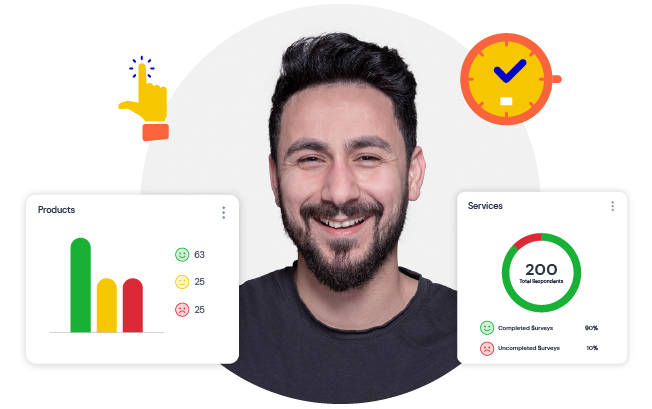Surveys are a highly effective way to gain valuable insight into your customers’ needs and expectations. Data can help you understand your audience and create custom messaging that resonates with them. This also enables you to provide a positive customer experience, which can benefit your business in several ways. To gain the insight required to for effective marketing campaigns, you should first learn what quota sampling is and how you can incorporate it into your research efforts.
What is Quota Sampling?
Quota sampling is a purposive or non-probability sampling method where subjects are selected based on certain mutually-exclusive criteria. This means they only qualify for one category and thus cannot be included in more than one subgroup. Researchers note participants’ known traits, such as gender, age, and income level, then divide subjects into the appropriate categories.
From there, researchers use convenience or judgment sampling to gather enough data from each subset to meet a quota. Once this data has been collected, it is used to make a generalization about the population as a whole. However, it is important to keep population percentages in mind to make sure sample numbers correctly reflect the overall group.
There are two types of quota sampling:
- Controlled: There are restrictions on the choice of samples. Researchers’ selection is limited.
- Uncontrolled: There are no restrictions on sample choices. Researchers are free to choose subjects at will.
Quota sampling’s lack of random selection is what separates it from other sampling methods. For instance, when comparing quota sampling to stratified sampling, note that stratified sampling relies on simple random sampling to categorize subsets of subjects. While this can be effective under the right circumstances, random sampling doesn’t help you gain insight about certain traits or characteristics among particular groups of people. If that’s your goal, quota sampling is the ideal sampling method for your research study.
Quota Sampling Example
Although it can sound a bit confusing, quota sampling is actually very simple and commonly used. Here is a basic example of how quota sampling works.
A hypothetical researcher wants to find out which computer brand is most appealing to college students. He considers a sample size of 1,000 people, and only wants to hear from students who attend one of 20 private universities. Here’s how the researcher could use quota sampling to select his subjects.
First, he could divide the group by gender: 500 males and 500 females. Then, he could divide those subgroups further by age. To do so, he would need to look for 200 respondents from each age categories, including students who are 17-20, 21-24, 25-28, 29-32, and 33+ years old. He might look for responses from 700 undergraduates and 300 post-graduates. Finally, he could accept 50 responses from each school.
In any quota sampling study, once the criteria has been determined, the researcher can divide the subgroup any way that meets the needs of the study. For instance, in this example, the researcher divided grade level unequally to gain more valuable insight. Ultimately, the only requirement for quota sampling is to maintain accurate representation by ensuring that the sample group is proportionate to the overall population.
How to Perform Quota Sampling
Unlike some random sampling methods, quota sampling doesn’t require researchers to follow specific rules. Instead, there are merely guidelines to keep in mind. Here’s how to perform quota sampling in four easy steps.
Step 1: Identify Your Subgroups
Begin by dividing your sample population into exclusive subgroups so individuals can only qualify for one category. These categories should add specificity to your subjects, such as their gender, age, or level of education.
Step 2: Decide Proportions
Next, assess how proportionate the subjects are to the entire population. Then, maintain that same proportion within the sample population. This helps to improve data purity and reflect the population as a whole.

Step 3: Choose Sample Size
Use the proportion you determined in Step 2 to choose your sample size. The subjects should be an accurate representation of their subgroup’s overall population. For example, if your population is 5,000, you might choose a sample size of 500.
Step 4: Survey According to Quotas
Survey your subjects until you have reached your predetermined quota. When you’ve fulfilled your sample size, the study is complete.
Quota Sampling Advantages and Disadvantages
There are several reasons why researchers may choose to implement quota sampling in their studies. Some major advantages offered by quota sampling include:
- Accurate population representation: When assessing data, quota sampling considers population proportions. This ensures that the sample subjects are an accurate representation of the overall population. For instance, if the entire population is 58% male and 42% female, the sample subjects would be the same.
- Quicker to create and complete: With quota sampling, there’s no need to adhere to strict techniques for random sampling or sampling frame. It also enables researchers to infer the response of an overall population by only sampling a few.
- Affordable: Due to the number of subjects needed, random sampling can often force researchers to increase the budgets of their research studies. However, since quota sampling enables you to study large groups on a smaller scale, it’s much more affordable than other sampling methods.
- Simple and Easy to Understand: Quota sampling is not only easier to implement than other methods, it is also easier to understand. Responses are more straightforward and so interpreting them is a much less demanding task.
- Tracks subjects: The nature of quota sampling means it monitors the types of people that take the survey as well as the number of participants who fit each type. This helps track data and provides the opportunity for more control in the overall study.
Quota sampling is an effective, easy, and affordable way to categorize subjects for quick results anyone can understand. However, it also comes with some challenges, which include:
- Room for bias: Sample selection is not random and relies on the judgment or convenience of the researcher, so there’s a chance research bias could impact the sample selection. If an individual is approachable or seems eager to participate, they may be selected over someone else.
- Exclusivity is sometimes unclear: Subjects in quota sampling must be mutually exclusive so that they do not exist in multiple subgroups. There are times when these delineations are difficult to differentiate and people cannot be clearly categorized, thus impacting the survey process.
- Too many identifiers can be problematic: Groups must be mutually exclusive, so researchers may have to create additional sampling requirements to ensure people aren’t in overlapping categories. Too many identifiers can actually hinder the study by drastically increasing the sample size and requiring additional time and money to fund the project.
Though it is a highly beneficial method of research sampling, quota sampling isn’t necessarily the best method for every situation. It’s important to know when it could benefit you the most and when you may want to consider other options.
When to Use Quota Sampling
While there are several sampling methods you could use in your research studies, quota sampling is ideal for when you:
- Want to focus on a particular group: Quota sampling allows you to concentrate on a certain trait within a particular subgroup. It’s also perfect for comparing relationships between different groups.
- Need a quick turnaround: Because quota sampling doesn’t require a large investment of time, it can be completed fairly quickly. If you need results fast, quota sampling is a good method to consider.
- Have budget constraints: Since quota sampling is highly affordable, it’s the perfect option for businesses on a tight budget.
In circumstances when random sampling can’t provide the data you need, quota sampling can be a powerful tool for gaining consumer insight in your market research.
Take Advantage of Quota Sampling
CheckMarket provides the best-in-class survey software to help businesses quickly and easily obtain consumer insight. This helps our clients create more effective campaigns that reach the right people at the right time. Let us help you identify your ideal survey sample that can provide you with the information you need to shape your business strategies.
Want to learn more about quota sampling? Sign up for free and learn how we can help you identify an accurate representation of your subjects that will give you impactful results.


Leave a Reply